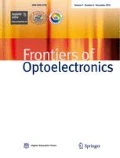Abstract
A series of novel aminoalkyl-substituted fluorene/carbazole-based main chain copolymers with benzothiadiazole (BTDZ) of different contents: poly[3,6-(N-(2-ethylhexyl)carbazole)-(9,9-bis(3′-(N,N-dimethyl-amino)propyl)-2,7-fluorene)-4,7-(2,1,3-benzothiadiazole)] (PCzN-BTDZ) were synthesized by Suzuki coupling reaction. Through a postpolymerization treatment on the precursor polymer, a corresponding quaternized ammonium polyelectrolyte derivatives: poly[3,6-(N-(2-ethylhexyl)carbazole)-(9,9-bis(3′-((N,N-dimethyl)-N-ethylammonium)propyl)-2,7-fluorene)-4,7-(2,1,3-benzothiadiazole)] dibromide (PCzNBr-BTDZ) were obtained. It was found that devices from such polymers with high work-function metal cathode such as Al showed similar device performance to that by using low work-function cathode such as Ba, indicating the excellent electron injection ability of these polymers. The efficient energy transfer from fluorene-carbazole segment to the narrow band gap BTDZ site for both the neutral and the quaternized copolymers was also observed. The addition of BTDZ into the polymer main chain can also improve polymer LED (PLED) device performance. When poly(3,4-ethylenedioxythio-phene) (PEDOT)/poly(vinylcarbazole) (PVK) was used as an anode buffer, the external quantum efficiency of the copolymer PCzN-BTDZ1 was 0.99%, which was much higher than the copolymer PCzN without the incorporation of BTDZ in the same device configuration.
Similar content being viewed by others
References
Burroughes J H, Bradley D D C, Brown A R, et al. Light-emitting diodes based on conjugated polymer. Nature, 1990, 347(6293): 539–541
Friend R H, Gymer R W, Holmes A B, et al. Electroluminescence in conjugated polymers. Nature, 1999, 397(6715): 121–128
Pinto M R, Schanze K S. Conjugated polyelectrolytes: synthesis and applications. Synthesis, 2002, (9): 1293–1309
Fou A C, Onitsuka O, Ferreira M, et al. Fabrication and properties of light-emitting diodes based on self-assembled mutilayers of poly(phenylene vinylene). Journal of Applied Physics, 1996, 79(10): 7501–7509
Huang F, Wu H B, Wang D L, et al. Novel electroluminescent conjugated polyelectrolytes based on polyfluorene. Chemistry of Materials, 2004, 16 (4): 708–716
Wu H B, Huang F, Mo Y Q, et al. Efficient electron injection from a bilayer cathode consisting of aluminum and alcohol-/water-soluble conjugated polymers. Advanced Materials, 2004, 16(20): 1826–1830
Huang F, Hou L T, Wu H B, et al. High-efficiency, environment-friendly electroluminescent polymers with stable high work function metal as a cathode: green- and yellow-emitting conjugated polyfluorene polyelectrolytes and their neutral precursors. Journal of the American Chemical Society, 2004, 126(31): 9845–9853
Huang F, Hou L T, Shen H L. et al. Synthesis, photophysics, and electroluminescence of high-efficiency saturated red light-emitting polyfluorene-based polyelectrolytes and their neutral precursors. Journal of Materials Chemistry, 2005, 15(25): 2499–2507
Huang F, Hou L T, Shen H L, et al. Synthesis and optical and electroluminescent properties of novel conjugated polyelec-trolytes and their neutral precursors derived from fluorene and benzoselenadiazole. Journal of Polymer Science Part A: Polymer Chemistry, 2006, 44(8): 2521–2532
Romero D B, Schaer M, Zuppiroli L, et al. The role of carbazole in organic light-emitting devices. Synthetic Metals, 1996, 80(3): 271–277
Lee J I, Klaerner G, Miller R D. Oxidative stability and its effect on the photoluminescence of poly(fluorene) derivatives: end group effects. Chemistry of Materials, 1999, 11(4): 1083–1088
Huang J, Xu Y S, Hou Q, et al. Novel red electroluminescent polymers derived from carbazole and 3,6-Bis(2-thienyl)-1,2,7-benzothiadiazole. Macromolecular Rapid Communications, 2002, 23(12): 709–712
Huang J, Niu Y H, Yang W, et al. Novel electroluminescent polymers derived from carbazole and benzothiadiazole. Macromolecules, 2002, 35(16): 6080–6082
Wang D L, Moses D, Bazan G C, et al. Conformation of a conjugated polyelectrolyte in aqueous solution: small angle neutron scattering. Journal of Macromolecular Science Part A: Pure and Applied Chemistry, 2001, 38(12): 1175–1189
Hung L S, Tang C W, Mason M G. Enhanced electron injection in organic electroluminescence devices using an Al/LiF electrode. Applied Physics Letters, 1997, 70(2). 152–154
Yang X, Mo Y, Yang W, et al. Efficient polymer light emitting diodes with metal fluoride/Al cathodes. Applied Physics Letters, 2001, 79(5): 563–565
Cao Y. US Patent, 08/888316, 1997
Cao Y, Yu G, Heeger A J. Efficient, low operating voltage polymer light-emitting diodes with aluminum as the cathode material. Advanced Materials, 1998, 10(12): 917–920
Cao Y, Yu G, Heeger A J. Efficient, low operating voltage polymer light-emitting diodes with aluminum as the cathode material. Synthetic Metals, 1999, 102(1–3): 881–884
Shaheen S E, Jabbour G E, Morrell M M, et al. Bright blue organic light-emitting diode with improved color purity using a LiF/Al cathode. Journal of Applied Physics, 1998, 84(4): 2324–2327
Author information
Authors and Affiliations
Corresponding author
Additional information
__________
Translated from Chinese Journal of Luminescence, 2006, 27(4): 547–552 [译自: 发光学报]
Rights and permissions
About this article
Cite this article
Cao, W., Dong, H., Huang, F. et al. Synthesis, optical and electroluminescent properties of novel polyfluorene/carbazole-based conjugated polyelectrolytes and their precursors. Front. Optoelectron. China 1, 299–304 (2008). https://doi.org/10.1007/s12200-008-0007-3
Published:
Issue Date:
DOI: https://doi.org/10.1007/s12200-008-0007-3




